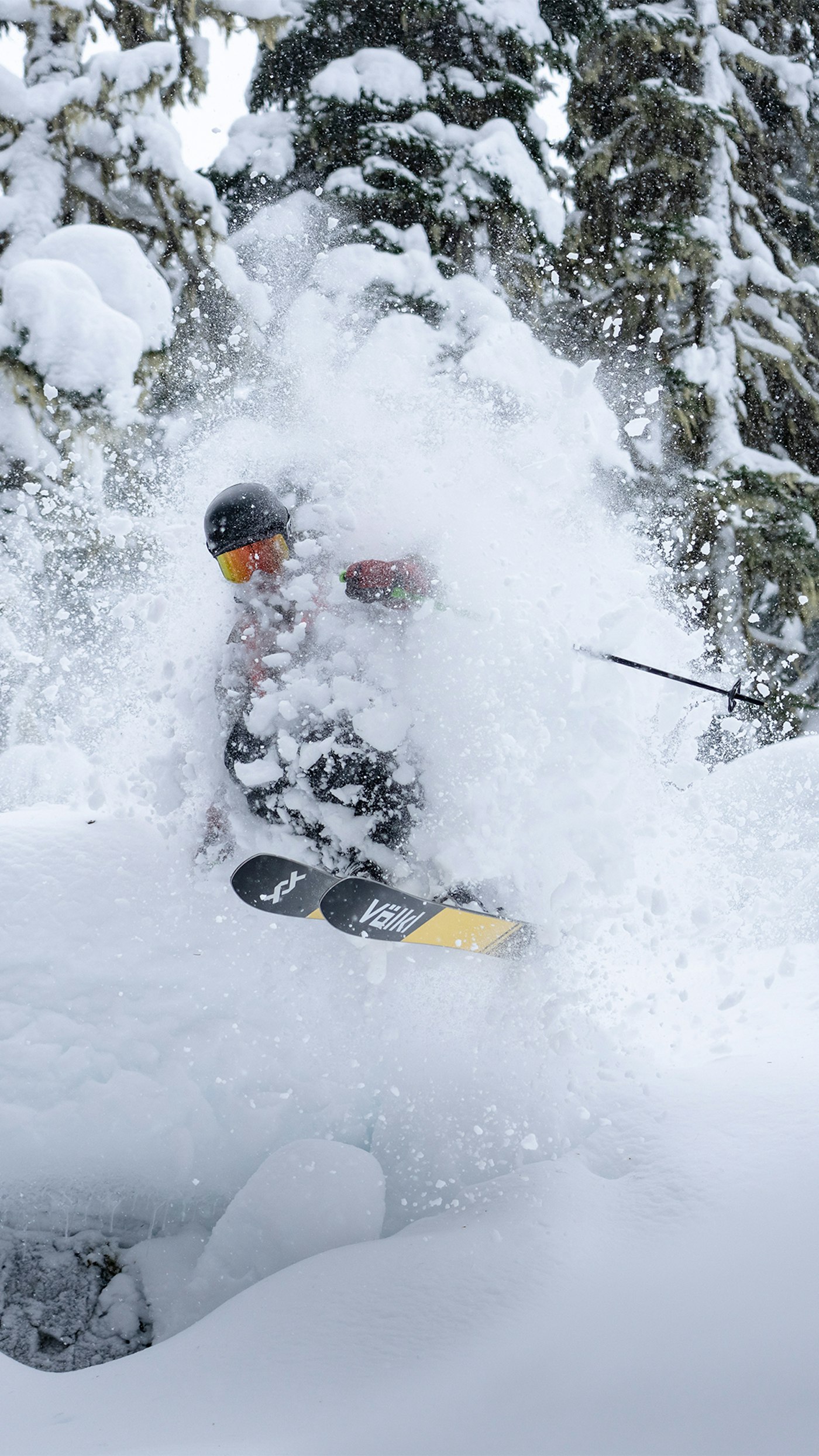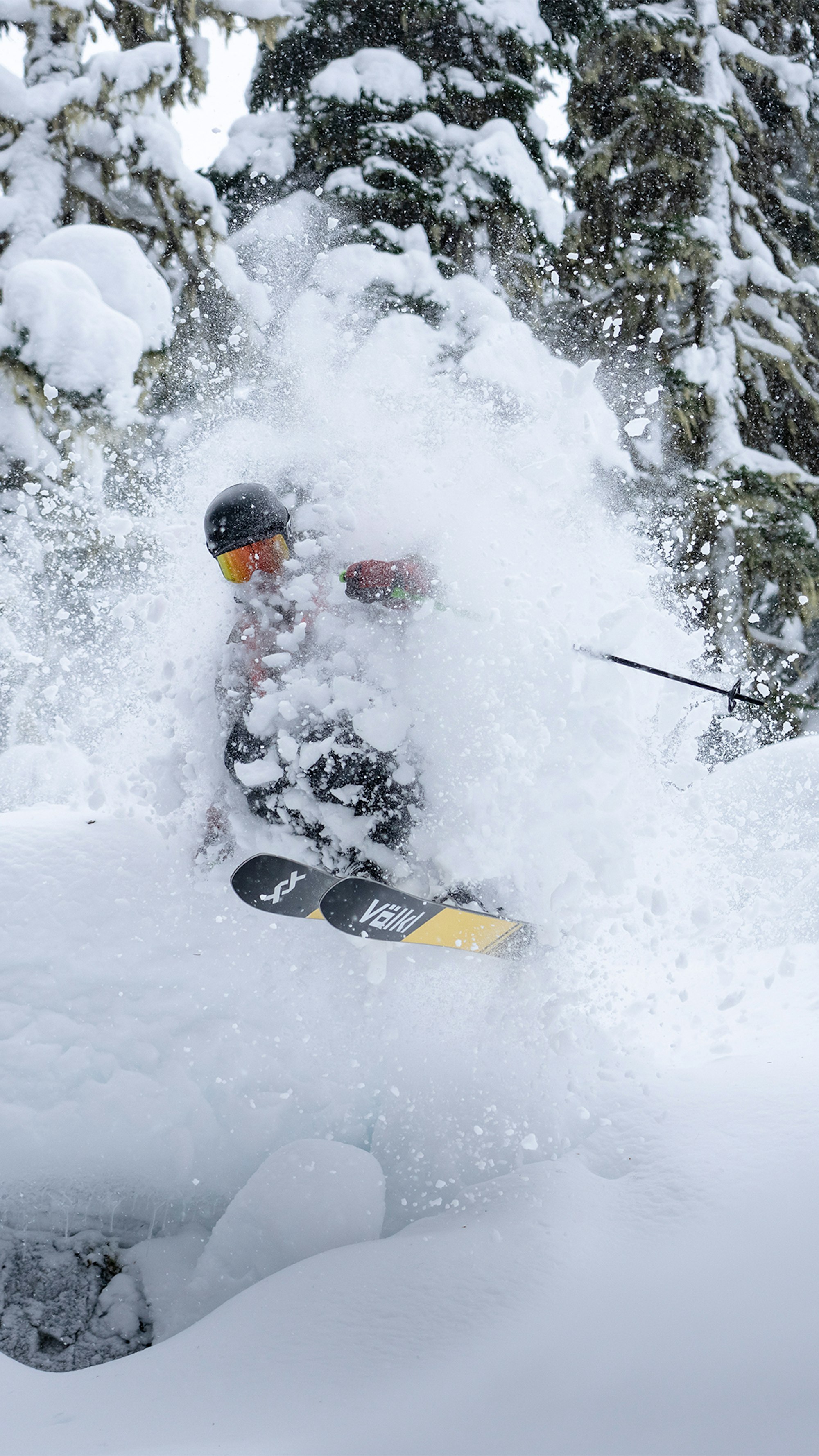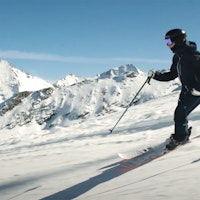Featured Image: by Mason Mashon
Lengths: 177, 184, 191 cm
DIM: 146-114-128 mm
Radius: 19 m @ 184 cm
In 2017, Völkl executives gathered a group of about 10 of their sponsored skiers and asked them to design a new ski. “It was one of the few times we’ve given athletes total control of the project,” says Chris McKenna, a Product Manager for Völkl. “We call the program ‘Built Together,’ it’s our best athletes working directly with the engineer, the freeski product and team manager, and the artist to make a great ski.”
During that meeting, the skiers came up with the design for the Revolt 121. In 2020, they followed up that project with the Revolt 104. Both of those skis are free-ride twin tips—jibby boards designed to be slashed around and skied switch. When the group met again in 2021 to add to the Revolt series, they wanted something different. “We told the engineer that we wanted a ski that’s the pissed off little brother of the 121,” says Ian McIntosh, a professional skier, adventurer and guide, who has been part of the Völkl athlete team for 13 years. “We wanted it to share some characteristics—good sidecut for performing on hardpack, for example—but we wanted it to be more aggressive and more directional.”


To that end, the team began to develop the Revolt 114, a hard-charging ski designed to ski big, steep lines. “The vast majority of people don’t ski backwards,” says McIntosh. “So we needed to add a ski to this line that was made for those people.”
McIntosh and the rest of the crew submitted design details to Lucas Romain, the Lead Engineer for the Revolt collection. “Lucas is a very talented skier who could be pro himself,” says McIntosh. “So he really gets it. We gave him our instructions and he made a bunch of prototypes based on those specs.”
The team got together in Stubai, Austria in the fall of 2021 to test the prototypes over two days, giving Romain notes on the side cut. Romain returned to the factory in Straubing, Germany and used the feedback to create some more prototypes, which were tested in Kitzsteinhorn, Austria in May of 2022. “That got us where we needed to be for the shape of the ski,” says McIntosh. “Then there was one more round of testing in Argentina where we dialed in the flex of ski.”
The result is a maple and aspen wood core ski that uses the same 3D radius construction (a sidecut that has shorter radius underfoot and longer radius in the tip and tail) that Völkl employs in both the Mantra and Katana. At just under five pounds per ski (size 177 cm), it weighs more than the 121, but it’s damper and more stable. “That helps you at speed or cutting through crud,” says McKenna. “But if you need to release the tail in tighter spot in a chute or ditch speed, that straighter sidecut in the tail allows it to release easily. It’s a great ski for that Jackson Hole, Little Cottonwood Canyon, or Aspen local or any aspiring freeride skier.”
![[Deep Dive] Völkl Revolt 114 Review](https://www.datocms-assets.com/163516/1751468446-23_24-vlkl-revolt-freeride-mason_mashone-ian_mcintosh-kye_petersen-austin_ross-kanada-dsc00754.jpg?auto=format&bg=FFFFFF&w=100)
![[Deep Dive] Völkl Revolt 114 Review](https://www.datocms-assets.com/163516/1751468446-23_24-vlkl-revolt-freeride-mason_mashone-ian_mcintosh-kye_petersen-austin_ross-kanada-dsc00754.jpg?auto=format&bg=FFFFFF&w=1200)
![[GIVEAWAY] Win a Legendary Ski Trip with Icelantic's Road to the Rocks](https://www.datocms-assets.com/163516/1765233064-r2r26_freeskier_leaderboard1.jpg?w=200&h=200&fit=crop)
![[GIVEAWAY] Win a Head-to-Toe Ski Setup from IFSA](https://www.datocms-assets.com/163516/1765920344-ifsa.jpg?w=200&h=200&fit=crop)


![[GIVEAWAY] Win a Legendary Ski Trip with Icelantic's Road to the Rocks](https://www.datocms-assets.com/163516/1765233064-r2r26_freeskier_leaderboard1.jpg?auto=format&w=400&h=300&fit=crop&crop=faces,entropy)




![[GIVEAWAY] Win a Head-to-Toe Ski Setup from IFSA](https://www.datocms-assets.com/163516/1765920344-ifsa.jpg?auto=format&w=400&h=300&fit=crop&crop=faces,entropy)


![[Deep Dive] Völkl Revolt 114 Review](https://www.datocms-assets.com/163516/1751468446-23_24-vlkl-revolt-freeride-mason_mashone-ian_mcintosh-kye_petersen-austin_ross-kanada-dsc00754.jpg?auto=format&bg=FFFFFF&w=2000)